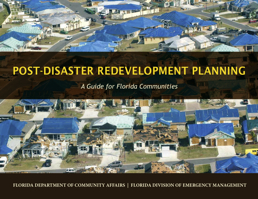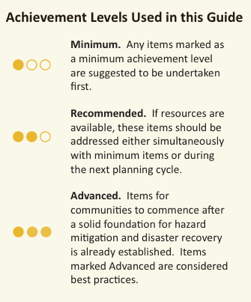 The Florida Department of Community Affairs and Florida Division of Emergency Management yesterday released its long-awaited Post-Disaster Redevelopment Planning: A Guide for Florida Communities. [QUICK NOTE: while this is written for Florida, it’s likely to be useful for communities anywhere in the US.]
The Florida Department of Community Affairs and Florida Division of Emergency Management yesterday released its long-awaited Post-Disaster Redevelopment Planning: A Guide for Florida Communities. [QUICK NOTE: while this is written for Florida, it’s likely to be useful for communities anywhere in the US.]
From their announcement:
Over the past four years the Department and the Division, guided by a statewide group of experts partnered to focus on community resiliency and long-term redevelopment through Post-Disaster Redevelopment Planning. This initiative included researching lessons learned during previous disasters, applying this research during the drafting of a planning process and testing the process through a series of pilot projects. The guidebook is the culmination of this effort.
Even a quick read through the document takes a bit of time (though not as much as one might expect for its 150 well-illustrated pages), but if your community is considering creating a post-disaster management plan (and if it isn’t, it should) it’s time well spent. The document painlessly walks the reader through the what, why, and how of post-disaster response plans. Find the complete table of contents at the end of this post.
Some of the included well-reasoned arguments in favor of post-disaster response plans might help readers sell reluctant fellow decision makers in their communities to come on board with the effort. For example, the handbook suggests that a post-disaster response plan is critical to maintaining local control over redevelopment after a disaster and getting funding in that competitive market:
While outside resources are needed and welcomed in a major or catastrophic disaster, a locally developed Plan will best channel those resources to effectively meet the community’s specific needs and goals. A Post‐Disaster Redevelopment Plan will show outside agencies and donors that the community is prepared to play an active role in the recovery process and promote its capabilities to wisely use donated and loaned resources. There will always be rules and, occasionally, strings attached to external sources of funding, but a community that has researched the allowable uses of Federal and State assistance can better work within their boundaries in an effort to fund projects that further local redevelopment goals. [page 5]
 One great feature of this handbook is that it takes a stab at recommending different activities as nearly mandatory to ideal (they call the three levels “minimum,” “recommended,” and “advanced”—see the table to the right). This makes the laundry-list of suggestions quickly manageable. Among the wise advice it labels as advanced: taking advantage of the post-disaster response plan to address future sea level rise.
One great feature of this handbook is that it takes a stab at recommending different activities as nearly mandatory to ideal (they call the three levels “minimum,” “recommended,” and “advanced”—see the table to the right). This makes the laundry-list of suggestions quickly manageable. Among the wise advice it labels as advanced: taking advantage of the post-disaster response plan to address future sea level rise.
All in all, an easy-to-use, well-written handbook, likely to be useful for coastal decision makers around the country: highly recommended.
Download: Post-Disaster Redevelopment Planning: A Guide for Florida Communities
Also see the StormSmart Coasts page on post-disaster response planning.
TABLE OF CONTENTS
Chapter 1. Getting Started
What is a Post-Disaster Redevelopment Plan?
Why Should My Community Develop a PDRP?
Different Approaches to Plan Development
Key Ingredients for Plan SuccessChapter 2. Planning Process
Initiating the Process
Getting Buy‐In
Capacity Assessment
Vulnerability Analysis
Facilitating InputChapter 3. Plan Topics
Land Use
Housing
Economic Redevelopment
Infrastructure and Public Facilities
Health and Social Services
EnvironmentChapter 4. Implementation Considerations
Pre‐Disaster Implementation
Post‐Disaster Implementation
Financing Implementation
Including the Public in Implementation